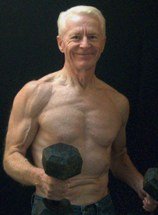| Back to Back Issues Page |
 |
|
The Gray Iron Fitness Newsletter, Issue #101, How to use progressive resistance exercise. November 01, 2012 |
Hi
November 1, 2012
In this newsletter . . . Progression defined, and ways to use it to your advantage.Tired of Commuting to the Gym?The word "progressive," as it is used here, has nothing to do with politics. It has everything to do with working out. Progression is an ancient training concept begun in southern Italy in about 500 B.C., by a man named Milo. People before him had exercised by lifting heavy objects, but historians credit Milo as the first one to really have the progressive part of training figured out. What Milo did one day was shoulder a small calf and carry it the length of the stadium at Olympia. The story goes that he continued regularly carrying the animal until it was full-grown. Thus Milo got progressively stronger as the animal got progressively heavier. Once you understand the story of Milo, you understand the foundation of all progressive resistance training, a.k.a. weight training, pumping iron, etc. In the beginners’ book, Gray Iron: A Fitness Guide for Senior Men and Women, I start novices off with a straight-line resistance progression. It works like this: The beginner does an exercise with a comfortable weight for 12 repetitions. At each subsequent workout, one repetition is added. When 15 repetitions are reached, weight is added and the repetitions drop back to 12. You keep repeating the sequence. Of course straight-line progression cannot go on forever. But the idea is to continue the standard approach as long as you can. When it gets tougher to keep adding weight or reps, you then give your body more time to adjust to the greater demand by staying with the same weight and reps for two or three consecutive workouts, before moving up in resistance or reps. Of course everyone eventually reaches a time when adding more weight or reps seems next to impossible. This is called hitting a “sticking point” or reaching a “plateau.” Getting past sticking points requires other tricks of the trade. For now, let’s stay with ways to use progression. Besides adding reps and then weight, you can also use progression in other ways, such as the following: • Add sets: If you have been doing, say, three sets of 10 reps, add a set and do four. Keep in mind, though, if too many sets are added over-training is possible. Think it through, and if you find you are not recovering (e.g. still tired) after a night’s sleep, you may be overdoing it. • Another method is to take shorter rests between sets: Suppose you are resting 90 seconds between sets. Cutting rest time in 10-second increments is also a form of progression. Remember too that resistance progression is not exclusive to using free weights. The same principles can be applied when using exercise machines, resistance bands, or doing bodyweight calisthenics.

Tired of Commuting to the Gym?Have you been thinking about the time you could save if you didn't have to drive to the gym, park, workout, shower, dress, and then drive home? You aren't alone. Many dread the crowded highways and parking ritual. They say they’d rather workout at home, but think they lack the space or they don't want to invest big money in equipment.I trained in gyms for years and taught classes in them. I liked it -- then. But today I workout at home; my equipment is modest and compact, and it works just fine. Unless you are doing the Olympic lifts or heavy power lifting, the equipment and arrangement I have might work for you too. It won't hurt to take a look at My Home Gym. You've probably heard about the tremendous benefits of weight training and how you can retain -- or even reclaim -- the attributes of youth . . . Discover the way with . . . Gray Iron: A Fitness Guide for Senior Men and Women
 Newsletter Policy The Gray Iron Fitness Newsletter is a free publication sent twice monthly to subscribers. The purpose is to provide honest and realistic fitness information for people age 50 and above. I have never been paid or received compensation of any kind to write a positive review or endorse a product. If I say that I personally use a product or service, it is because I find value in it and have paid for it with my own money. Like newspapers, magazines and television, this newsletter and my web site contain advertising and marketing links. Naturally, I am compensated for these. The newsletter and web site provide information to help users establish and maintain a fitness lifestyle. But fitness information is not the same as fitness advice, which is the application of exercise and dietary practices to an individual's specific circumstances. Therefore, always consult with your physician for assurance that fitness information, and your interpretation of it, is appropriate for you. Your comments and questions are always appreciated. Simply click on the "Reply" bottom. |
| Back to Back Issues Page |